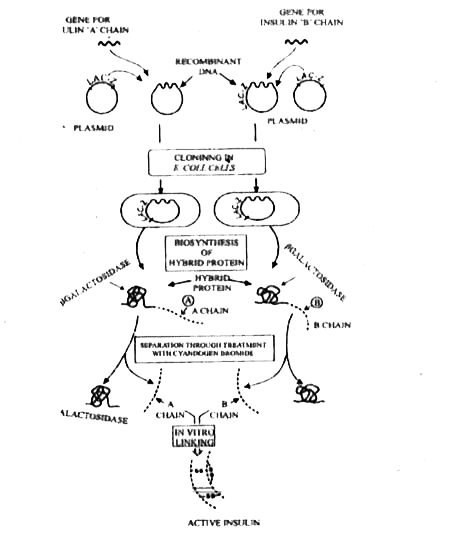Write a brief account on genetically engineered insulin.Solution in Kannada
The process of synthesis of human insulin through recombinant DNA technology involves the following steps.
1. Isolation of insulin gene [ or desired gene].
2. Insertion of insulin gene in to plasmid.
3. Transfer of recombinant plasmid to Ecoli cell.
4. Selection or isolation and culture of Ecoli cells having r-DNA.
5. Extraction of human insulin.
1. Obtaining the insulin gene: The human insulin gene can be obtained by collecting the mRNA for insulin protein from b cells of islets of Langerhans of pancreas. From this mRNA, complementary DNA [ C- DNA] is synthesized by using reverse transcriptase or RNA dependant DNA polymerase enzyme.
2. Insertion of insulin gene into plasmid to produce rDNA: The plasmid pBR 322 is taken and is cut with the help of restriction endonuclease [ Hind III]. Now inslin, gene or cDNA for insulin is inserted by the side of a galactosidase gene. The ends are joined by using DNA plasmid is called recombinant plasmid or recombinant DNA.
3. Transfer of r-DNA or r plasmid into E.coli cells: A culture of E.coli cells are taken and mixed with r-DNAs or r-plasmids having gene, and the mixture is treated with cold calcium chloride [CaCI2]. After sometime the temperature of the solution is suddenly raised to 42∘C This makes the plasma membrane of the host cell more permeable. This result in the easy entry of r-DNA into the E.coli cells.
4. Selection or isolation and culture of E.coli cells having r-DNA: E.coli cells that have received r-DNA for insulin are isolated from the mixture by using the specific antibiotic in the media. Those E.coli cells that have received r-DNA will survive as the resistance gene REN and the desired gene is inserted in this place. Such cells DNA are selected with r-DNA by using replica plating technique. These selected E.coli cells are then cultured in bioreactors for large scale production. These cells produce insulim hormone in lagre quantities.
5 . Extraction of insulin: The insulin synthesised in recombinant E.coli cells is human insulin. It contains B-galactosidase removed by treating with cyanogen bromide to from proinsulin. This proinsulim contains 3 chains designated as 'A' 'B' and 'C' chains. This proinsulin is inactive due to the 'C' chain which connects 'A' chain [21 aa] and 'B' chain [30aa]. Chain 'C' is cut off by treating the proinsulim with trypsin. This process results in the formation of active human insulin or Humulin.

Topper's Solved these Questions
- BOOK - SUBHASH PUBLICATIONCHAPTER - BIOTECHNOLOGY AND ITS APPLICATIONEXERCISE - THREE MARKS QUESTIONS AND ANSWERS1videos
BIOTECHNOLOGY AND ITS APPLICATION
- BOOK - SUBHASH PUBLICATIONCHAPTER - BIOTECHNOLOGY : PRINCIPLES AND PROCESSESEXERCISE - FIVE MARK QUESTIONS AND ANSWERS4videos
BIOTECHNOLOGY : PRINCIPLES AND PROCESSES
- BOOK - SUBHASH PUBLICATIONCHAPTER - ECOSYSTEM EXERCISE - FIVE MARKS QUESTION ANSWERS9videos
ECOSYSTEM
Similar Questions
What is molecular diagnosis ? E xplain .
04:02View SolutionExplain the process of recombinant DNA technology.
02:28View SolutionWhat is an ecosystem ? How soes material and energy flow occur is an ecosystem ?
02:00View SolutionGenetically Engineered Insulin
04:03View SolutionGenetically engineered human insulin is called
03:21View SolutionWrite an account of practical applications of genetic engineering
02:28View Solutionआनुवंशिक अभियान्त्रिकी पर संक्षिप्त टिप्पणी लिखिए।
View SolutionGenetically engineered insulin is more advantageous.
05:11View SolutionGenetically engineered human insulin is called
04:29View SolutionGenetically engineered insulin deffers from natural insulin in:
03:35View SolutionWhat is genetically engineered insulin ?
04:28View SolutionWrite a short note on genetically engineered insulin.
02:44View SolutionExplain genetically engineered insulin.
02:00View SolutionGive a brief account of recombinant insulin.
00:40View SolutionGive a brief account of genetic engineering.
02:25View SolutionGive a brief account of genetic engineering.
02:17View Solution

